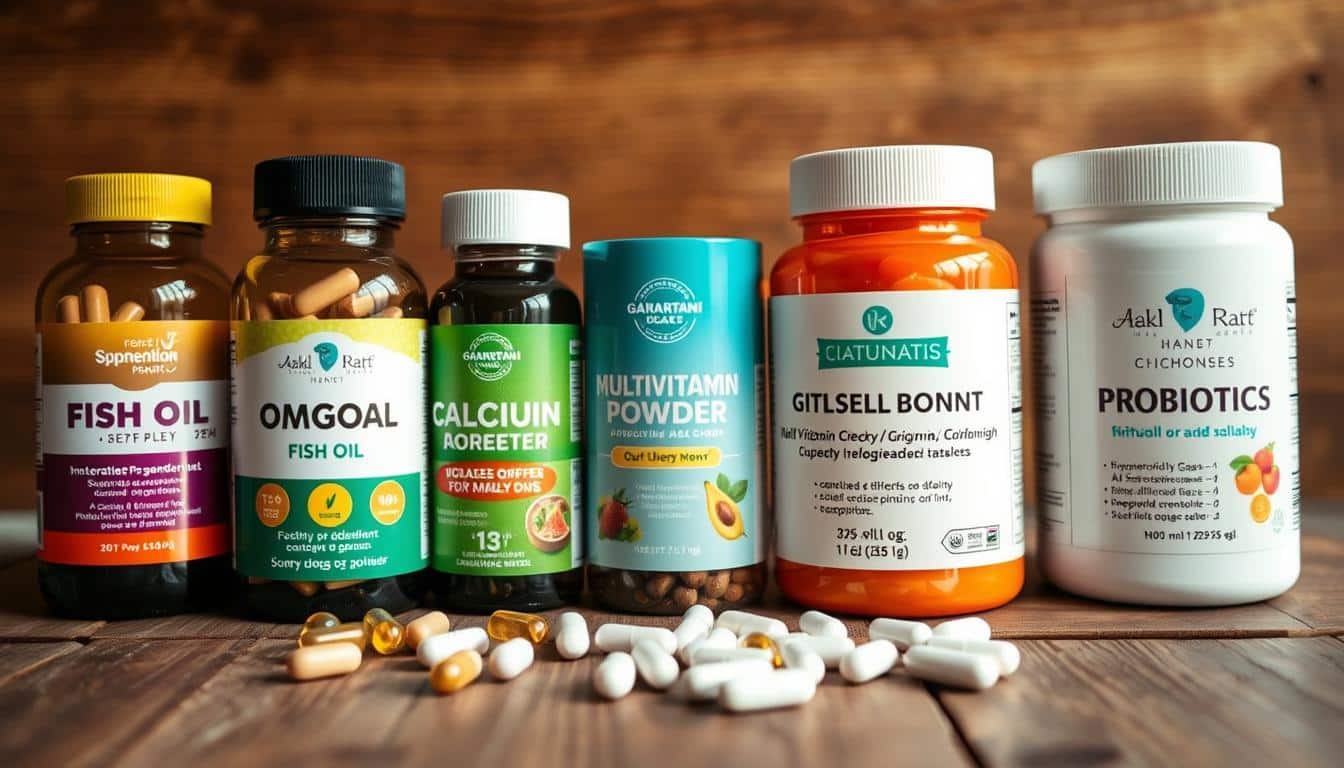Choosing the right oils is important for your small dog’s health. These oils help with their fats, skin, and overall nutrition. We’ll tell you why to choose stable, minimally processed oils. They improve digestion, make coats shiny, and reduce inflammation.
Guides like Hearthstone Homemade recommend soybean, corn, and canola oils. They offer important fatty acids that are good for your dog. Using oils like LifeOil, which are expeller-pressed and non-hexane, keeps the good stuff in. This makes homemade meals healthier for your pet.
Experts say adding fish or krill oil is good for omega-rich nutrients. But, be careful of giving too much. It could lead to extra calories and health risks. Keeping a balance between omega-6 and omega-3 fats is crucial. This helps prevent inflammation and supports the immune system.
We’ll look into the best cooking oils for small dogs. You’ll learn about safe options and what oils to stay away from. Plus, get tips to keep those nutrients in and avoid bad oil. Stay tuned for advice on using cooking oils safely for your dog’s meals.
Why dietary fats matter for small dogs: skin, coat, and immunity
Fats do more than provide energy for small dogs. They make the skin soft and the coat shiny. They also boost the immune system. The right fats can help a small dog stay healthy without gaining extra weight.
Role of essential fatty acids in canine health
Dogs need essential fatty acids like omega-6 and omega-3. These fats work in cells, help with hormones, and fix tissues. Having the right mix can cut down on swelling and keep dogs feeling good.
How linoleic acid (omega-6) supports skin barrier and waterproofing
Linoleic acid is key for strong skin cells in dogs. It keeps the skin moist and waterproof. Without it, dogs might get flaky skin, dull fur, and be more bothered by irritants.
How alpha-linolenic acid (ALA) and long-chain omega-3s (EPA/DHA) reduce inflammation
ALA helps control omega-6 and cuts down on itching. EPA and DHA, kinds of omega-3s, fight swelling. They’re so good that vets use them to ease joint pain and help older dogs think clearer.
Why bioavailability of fatty acids matters for small-breed metabolism
Small dogs need fats they can easily use because they burn energy quickly. Plant oils offer ALA, but dogs can’t turn it well into EPA/DHA. That makes direct sources of these fats key for fighting inflammation and brain health.
- Keep the ratio of omega-6 to omega-3 between 1:1 and 4:1 to stay healthy.
- Try to use marine sources of EPA/DHA along with omega-6 when you can.
- Watch how much you feed them to keep their energy up without too many calories.
Safe oils to cook for small dogs
Picking the right oil is key to keeping essential fats and flavor in dog food. This guide looks at the best oils, how they’re made, and how heat changes their goodness for small dogs.
Canola (rapeseed) oil: balanced ALA and practicality for cooking
Canola oil mixes ALA and linoleic acid with little saturated fat. It tastes mild, which is great for many dog foods. Plus, it’s easy to use for small servings. Refined canola works well for light frying without losing important fats.
Corn oil and soybean oil: preformed linoleic and practical considerations
Corn oil is rich in ready-to-use linoleic acid for dogs. Soybean oil has a good mix of linoleic and ALA, making it a top choice for regular dog meals. With these oils, watch the omega-6 levels and mix in omega-3 sources for a balanced diet.
Choosing expeller-pressed or cold-pressed varieties to protect fatty acids
The way oils are made is crucial. Expeller-pressed and cold-pressed oils are made without harsh chemicals and too much heat. This keeps the nutrients better. Brands matter less than the process. Expeller-pressed oils have more antioxidants and vitamin E. Non-solvent methods like those used by LifeOil keep the good fats more usable for small dogs.
Smoke point and cooking methods appropriate for small-dog meals
The smoke point should guide what oil you use for dog food. Higher smoke-point oils are good for some frying. But don’t cook it too hot or for too long. Low heat works best for fragile oils. You can also add these oils after cooking to save their health benefits. This keeps the food safe and nutritious for small dogs.
- Best for light cooking: refined canola and some corn and soybean oils.
- Best for nutrient preservation: expeller-pressed oils and cold-pressed batches.
- Balance tip: pair corn oil dogs or soybean oil dogs with omega-3 sources to reduce excess omega-6.
Best supplemental oils for small dogs: omega-3 sources
Choosing the right omega-3 supplement is key for your small dog’s joints, skin, coat, and brain. These supplements provide crucial EPA and DHA fats that might not be in home-cooked meals. Always select products tested by third parties and listen to your vet about dosage.
Fish oil and salmon oil
Fish oil for dogs offers important EPA and DHA. It helps reduce inflammation from arthritis and skin issues. Look for pure, NASC-certified brands to avoid problems like mercury. Store them in a cool, dark spot, and if they smell bad, it’s time to throw them out. Stop giving omega-3s five days before any surgery to avoid extra bleeding.
Krill oil and sustainability
Krill oil gives your dog EPA and DHA in an easily absorbed form. Krill’s low in the food chain, so it’s usually less contaminated. It’s as beneficial as fish oil for your dog’s joints and fur. Make sure your krill oil supports environmental safety.
Algal oil for fish-sensitive pets
For dogs allergic to fish, algal oil is a great option. It provides DHA from algae, not fish. This supports brain and eye health in young and old dogs alike. Since it’s an alternative to fish oil, it’s good for reducing inflammation too.
Plant ALA oils and conversion limits
Flaxseed, chia, and hemp oils offer ALA, a type of omega-3. However, dogs can’t turn ALA into EPA and DHA efficiently. So, plant-based ALA might not be enough. It’s best to combine these with direct EPA/DHA sources or try SDA-rich oils like ahiflower.
Practical tips for supplementation
- Rotate sources to balance omega profiles and reduce contaminant exposure.
- Begin with small doses. Watch your dog’s stool, appetite, and coat health.
- Talk to your vet about any drug interactions, especially with blood thinners or before surgery.
Oils to avoid or use cautiously when cooking for dogs
Not all kitchen oils are good for dogs. Some can’t handle heat well or don’t have the right fatty acids. Others might harm your dog’s health or the environment, making them bad choices for small-dog meals.
Coconut and olive oil: limitations and cautions
Coconut oil has beneficial fats but is also loaded with saturated fat. So, it’s best to use it sparingly and check with a vet before making it a regular part of your dog’s diet. Olive oil is packed with good fats and antioxidants, but it’s not great for high heat cooking. It has a low smoke point. Both oils have fats that dogs struggle to turn into necessary acids for healthy skin and coats.
Walnut, sesame, and flaxseed oil: finishing oils only
Walnut, sesame, and flaxseed oils are full of fragile fats and antioxidants that hate heat. Use these oils to finish dishes, adding them after cooking. Cooking with them destroys important acids and lowers the health benefits for dogs.
Partially hydrogenated oils, palm oil, and cottonseed oil: avoid or limit
Avoid partially hydrogenated oils because they contain bad trans fats. These fats can damage your dog’s heart health. Palm oil is not eco-friendly and is packed with saturated fats, making it a bad choice for small dogs. Cottonseed oil could have harmful residues and too much omega-6, which isn’t good for dogs.
- Oils to avoid dogs: partially hydrogenated and low-quality industrial oils.
- Coconut oil dogs caution: limit portions due to saturated fat and check existing medical conditions.
- Olive oil cooking dogs: use extra-virgin olive oil as a finishing touch rather than for frying.
- Hydrogenated oils dogs: do not include trans-fat containing products in pet diets.
- Palm oil concerns: consider sustainable alternatives and avoid frequent use for small breeds.
When unsure, go for expeller-pressed or cold-pressed oils and choose oils with third-party testing. Making small changes in oils and how you use them can keep your dog healthy. It preserves the good fats they need for their skin, coat, and immune system but without the risks.
How to balance omega-6 and omega-3 in small dog diets
Getting the fats right is key for small dogs’ skin, joints, and general well-being. It’s about making smart choices that keep inflammation low and meet their energy needs. By swapping ingredients and adding supplements wisely, you can fix the omega balance without messing up meal times or their diet plan.
Experts in dog health say the best omega-6 to omega-3 ratio is between 1:1 and 4:1. If the ratio is higher, it can lead to more inflammation. Balancing these fats helps keep the skin healthy, reduces the chance of long-term inflammation, and keeps older small dogs moving well.
Common pitfalls with high omega-6 cooking oils.
Corn and sunflower oils are full of linoleic acid, pushing up the omega-6 levels. Using these oils alone increases inflammation. The key mistake to avoid is not adding any EPA/DHA sources to diets heavy in omega-6 oils.
How to correct high omega-6 in home-cooked meals.
- Swap some high-omega-6 oil for canola oil to get more ALA and improve the ratio.
- Add the right amount of fish oil or algal oil supplements for EPA/DHA, instead of just using plant-based ALA.
- Keep an eye on total calories when adding omega-3 supplements to avoid weight gain in small dogs.
Practical ingredient swaps to improve balance.
Make easy swaps in your dog’s food for a healthier nutritional mix. Replace half the sunflower oil with canola when making chicken or turkey. Include a teaspoon of hemp seed oil at mealtime for a quick plant balance boost. Or, use fish or krill oil as recommended by your vet to fast-track the EPA/DHA intake.
Sample adjustments in three steps.
- For any recipe using 2 tablespoons of corn oil, mix 1 tablespoon of corn oil with 1 tablespoon of canola oil.
- Add a 1/4 teaspoon of hemp seed oil or the vet-suggested amount of algal oil for small dogs when serving.
- Opt for NASC-certified fish oils and follow the dosing tips to keep calories in check and ensure quality.
These simple tweaks help balance fatty acids in your dog’s diet easily. They ensure your dog gets the full benefits of fish and plant oils while preventing the usual issue of too much omega-6 in homemade meals.
Cooking tips for small dogs: preserving nutrients and preventing rancidity
To keep your dog healthy, start in the kitchen. Use low-to-medium heat and cook for short times. This saves the fatty acids in their meals. Choose the right oils for cooking like refined canola, corn, or soybean for light sautéing. Cold-pressed oils are best for adding at the meal’s end.

Pick oils that are expeller-pressed or cold-pressed when you can. They keep the fats healthy if you don’t use high heat. Stay away from oils made with chemicals or hexane to avoid bad fats and residues.
How you store oils matters a lot. Keep them cool and away from light or heat. Oils like flaxseed and fish oil should go in the fridge once opened. This keeps them fresh longer.
- Always check the smell and taste of oils; throw out any that smell bad.
- Use oils before they go bad; look at the dates on them.
- Buying smaller bottles helps keep the oil fresher by limiting air contact.
Choose the oil form that matches the food. Liquid oils mix well with wet food. This makes meals taste better and coats the kibble evenly. Add the oil right before you serve it to prevent the oil from going bad.
Capsules and softgels are handy for giving supplements. They keep the oil fresh and make it easy to give the right amount. If your dog is picky, try mixing oil from a pierced capsule into their food. Start small to see how they handle it.
- Cook with low heat and quickly to keep the fats healthy.
- Store your oils the right way and cool the sensitive ones.
- Add liquid oils to wet food for a tasty meal; finish with cold-pressed oils.
- Capsules make giving supplements clean and simple; follow guidelines to avoid giving too much.
Be on the lookout for bad smells and toss oils that don’t smell right. These steps help keep the oils good and safe for your small dog, avoiding the dangers of bad fats.
Portion guidance and safety considerations for small-breed dogs
Small-breed dogs should get just the right amount of oil in their food. Just a teaspoon of oil packs a lot of calories. This can be too much for tiny dogs. It’s important to track how much your dog eats every day. This helps prevent weight gain and keeps their diet balanced.
Before adding oil, check how many calories it has. Use small portions based on your dog’s weight—about 1/4 to 1/2 teaspoon for dogs under 10 pounds. Weigh your pet regularly and adjust the oil amount as needed. Keeping an eye on this helps maintain a healthy number of calories from oils.
Signs of over-supplementation
Pay attention to your dog’s poop and behavior after adding new oil to their diet. Too much fat can cause diarrhea, vomiting, or a decrease in appetite. Giving too much oil at once can lead to serious issues for some dogs. Watch out for signs of pancreatitis.
Recognizing pancreatitis risk oils
The risk of pancreatitis goes up with sudden or excessive fatty meals. Dogs that are overweight or have had pancreatic disease are more likely to get sick. Symptoms include belly pain, lots of vomiting, or tiredness. If you notice these, contact your vet immediately.
Trialing, dosing tools, and safety steps
- Introduce new oils to your dog’s diet slowly over a few days.
- Use tools like measured droppers or capsules for exact dosing.
- Keep track of how much oil you give, stool consistency, and your dog’s energy level in a journal.
Oil use around surgery and medications
Some oils can thin the blood and make it clot more slowly. So, you should stop giving your dog fish and krill oils before any surgeries. Vets usually say to stop these oils five days before and after surgery. This reduces the risk of bleeding. Always talk to your vet about when to stop and restart oils.
Oil drug interactions and fat-soluble vitamins
Oils might affect how some medications work, like blood thinners and some pain relievers. If your dog is on medicine, talk to your vet before adding oils to their diet. Using a lot of fats over time can also change how vitamins are used in the body. You might need to give your dog vitamin E if they are on omega oils for a while.
Practical checklist for owners
- Figure out how many calories your small breed dog needs and keep oil portions small.
- Start with a small amount of oil and watch for any digestive problems or behavior changes.
- Stop giving fatty supplements before surgery and talk to your vet about the best timing.
- Tell your vet about any medications your dog is on to avoid negative interactions with oils.
Choosing quality brands and reading labels for small-dog cooking oils
Selecting the right oil is about more than just cost or taste. Small dogs need oils from reliable sources, with simple making steps and proven purity. It’s important to understand oil labels to find safe options for your dog’s daily meals and health boosts.
- Look for reputable seals. The NASC seal on dog supplements shows that a product’s ingredients are lab-checked. This helps when choosing fish or salmon oil for your pet.
- Check for third-party testing. Pick fish oils tested by others for harmful metals and freshness indicators like peroxide and anisidine levels.
- Prefer gentle extraction. Look for soybean oil or vegetable oils made without harsh chemicals, protecting their beneficial fats.
When picking fish or algae oils, check the label for how much is in there and how to keep it fresh. Search for vitamin E for protection and storage tips like keeping it cool. For algae-based oils, find options that show DHA content and purity checks.
Practical selection tips:
- Choose products showing how and where they were made.
- Go for brands that share their test results or quality proofs.
- Steer clear of oils with unclear ingredients or sources.
For cooking oils, pick one that suits your cooking style. Use oils meant for high heat when cooking and ones like cold-pressed for finishing dishes. Look at the label for advice on smoke points and how to store them to keep them good and safe for your dog.
In the end, check the supplement dosage carefully, look for the NASC seal on supplements when you can, and choose fish, algae, or vegetable oils that have been third-party tested. Reading labels carefully avoids bad surprises and keeps your small dog healthy.
Recipes and serving ideas: simple cooked meals and finishing oil applications
Make your small dog’s meals simple to help their digestion. Use recipes that require low heat to keep the good fats safe and cut down on harmful changes. Begin with foods like lean meats, soft veggies, and oils good for cooking.
- Lightly cook diced chicken or turkey in a bit of refined canola oil on medium. Then, add steamed carrots and green beans. Let it cool before giving it to your dog. This keeps the meal rich in nutrients.
- If you don’t want grains, try poaching fish in water. Break it into flakes and mix in a teaspoon of corn oil for extra good fats. Keep the heat low to save the omega-3.
- Scramble lean ground turkey gently with a bit of soybean oil. Add cooked sweet potato to it for fiber and key vitamins.
Finishing oil recipes
- Put a little algal oil over your dog’s cooked meal to add DHA without heating it. Small dogs need just one or two drops, bigger ones a bit more.
- Add fish oil from a capsule to your dog’s meal once it’s cooled off a bit. This keeps the good EPA and taste without the heat.
- Mix flaxseed oil or extra-virgin olive oil with mashed pumpkin and put it on cool food. Serve it right away to keep the nutrients from breaking down.
How to introduce new oil to a small dog
- Start with very small amounts. For tiny dogs, just a drop on their food. Watch how they respond for a couple of days.
- If they’re doing well, you can give a bit more, gradually. But watch their total calories to keep them from gaining too much weight.
- For exact amounts, use the oil from a capsule. Mix it into moist food after it’s cooled to spread it evenly.
- If your dog gets an upset stomach or loose stools that don’t stop, see a vet.
Using these simple low-heat recipes and carefully measured finishing oils lets you improve your dog’s meals safely. Add oils to your dog’s food slowly and watch how they react to ensure it’s good for their digestion and health.
Conclusion
When cooking for small dogs, use oils like canola, soybean, and corn that are good for low-to-medium heat. Look for expeller-pressed or cold-pressed kinds to skip hexane and too much heat. Combine these with omega-6 oils and direct EPA/DHA sources like fish or krill oil. This way, you aim for a good omega-6:omega-3 ratio, from 1:1 to 4:1. This advice focuses on balance and being practical.
Choosing quality and safe supplements is vital. Go for those checked by NASC or another third party to reduce harmful substances and oxidation. Keep delicate oils in cool, dark spots. Capsules can be better for keeping oils fresh. Be careful with how much you give to avoid too many calories and pancreatitis risks. Also, stop omega-3 supplements before any surgery because they can increase bleeding.
Here’s a simple summary for feeding oils to small breed dogs. Pay attention to how easy it is for your dog to use the oil, make sure it’s from a trusted source, and use it in small, weight-appropriate amounts. Slowly introduce new oils and keep an eye on your dog’s coat, skin, digestion, and how they act. If you’re thinking about changing their diet or adding supplements, especially if they have health issues, talk to your vet first.
FAQ
What are the best safe oils to cook with for small dogs?
Why do dietary fats matter for small dogs’ skin, coat, and immunity?
What role does linoleic acid (omega-6) play in canine skin health?
How do ALA and long-chain omega-3s (EPA/DHA) reduce inflammation in dogs?
Why does bioavailability matter for small-breed dogs?
Is canola (rapeseed) oil a good choice for cooking dog meals?
How do corn oil and soybean oil compare for cooking dog food?
Should I use cold-pressed or expeller-pressed oils?
How important is smoke point and which cooking methods preserve fatty acids?
What are the best supplemental oils for small dogs to get EPA and DHA?
How do krill and algal oil compare to fish oil?
Are plant ALA sources like flax, chia, or hemp enough on their own?
Should I avoid coconut or olive oil for my dog?
Are walnut, sesame, or flaxseed oils safe for cooking?
Which oils should I avoid entirely for dog diets?
What is the ideal omega-6 to omega-3 ratio for dogs?
How do I correct a diet high in omega-6?
What cooking temperatures preserve essential fatty acids?
How should I store oils to prevent rancidity?
Can I mix oils with dry kibble or wet food?
How many calories do oils add and how do I adjust portions for small dogs?
What are signs of over-supplementation or oil-related problems?
Should I stop omega-3 supplements before my dog’s surgery?
How do I choose quality brands and read labels for oils and supplements?
Any practical brand-selection tips for fish, algal, and vegetable oils?
What low-heat meal ideas work well using canola, corn, or soybean oil?
How should I use finishing oils like algal, fish, flaxseed, or extra-virgin olive oil?
How do I introduce a new oil into my small dog’s diet?
Content created with the help of Artificial Intelligence.



